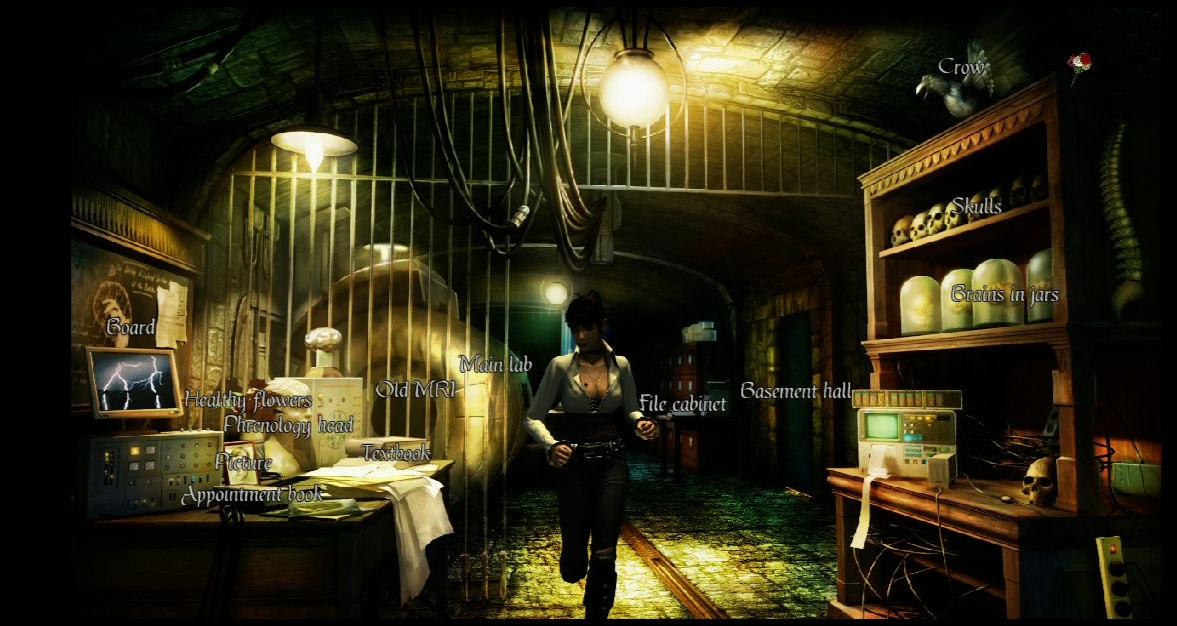Drawing on stage magic, grand illusions, ghosts, parapsychology, and clinical necromancy for ideas, Gray Matter's inspirations are greedily eclectic. Its story, a paranormal mystery-cum-melodrama, is absorbing and delivered with an ingenuous sincerity that makes even its cliches likable. It has got good looks and a decent pedigree, too, with Gabriel Knight author Jane Jensen as designer. But for an adventure game that sets the table, thematically speaking, with a spread this rich, Gray Matter's puzzles suffer a lack of ambition, and the plot is underserved by some mundane puzzling. Awkward controls mean the game never feels quite at home on the Xbox 360, either. If you can get past these weaknesses, there is a worthwhile adventure to be had, but this isn't an adventure game that will raise the bar for the genre.

As the game begins, goth heroine and aspiring stage magician Sam Everett takes a wrong turn on the road to London and breaks down outside of stately Dread Hill House. To get a bed for the night, she poses as the new assistant for Dr. Styles, the house's reclusive, Byronic master: a formerly brilliant neuroscientist obsessed with the memory of his dead wife. Soon, Sam is helping the doctor recruit students from nearby Oxford for an experiment in the mansion's gloomy underground lab while solving riddles from the Daedalus Club, the secret society of magicians that was her original destination. As Sam's magical ambitions and Dr. Styles' macabre research intertwine, the game switches between the two characters, spanning eight chapters. The plot builds steadily into a mystery around Styles' wife's death and apparent haunting of Dread Hill House; it's a slow-burning story, but will keep you clicking from chapter to chapter. It takes about 10 to 12 hours to complete; the really dedicated might aim for the five-hour speed-run achievement or collect all the bonus actions--nonessential interactions that add color or background to the plot.
For Sam, the puzzles are a mixture of Daedalus Club riddles--scavenger hunts with cryptic clues--and magic tricks used to pilfer items and coerce recruits to submit to Styles' experiment. The latter is a neat idea, asking you to work from Sam's recipe book of magic tricks to find the right combination of palming items, planting items, misdirection, and the like. But the execution is less impressive: a trick rehearsal window in which you queue the sequence of magical moves and then hit play. For Dr. Styles, puzzles involve collecting items associated with memories of his dead wife. Though these are some of the simplest puzzles, mostly solvable by clicking everything you find, they at least add weight to the character's single-minded, grief-stricken obsession. Until near the end of the game, though, no puzzle is really taxing or intricate. It feels like it hits its stride too late and all at once, when Sam is caught up in a kind of florid Alice in Wonderland funhouse.
While controlling character movement is fine, the point-and-click action for the Xbox 360 tends to be fiddly. On a radial menu, raised with a trigger, your 10 closest interactive items or hot spots are arranged around a wheel. You use the left stick to select one, but in this scheme, the direction of the hot spot on the wheel may not correlate with the direction of the hot spot in the environment, making for some frustrating moments in close-up, item-crowded scenes. Hot spot labels can be flicked on and off, at least, so you can see what your options are at a glance, and there's no pixel hunting here. There are useful progress bars to show percentage completion of a chapter and of puzzle sets within a chapter, and the quick-travel map highlights locations at which you still have work to do. But the lack of a hint system may slow you down on the few occasions when you lose the trail of a puzzle solution and need to backtrack.

There are plenty of quirks in Gray Matter's vision of England. Sam loses her way to London when the wooden signpost on the lonesome road that apparently connects London, Oxford, and Liverpool gets comically spun around in a storm. The various local accents encountered at an Oxford pub are anything but. What it lacks in authenticity, though, it makes up for in enthusiasm; the static, prerendered Oxford environments are meticulously done, as well as detailed and richly coloured. The historic Oxford colleges and stately Dread Hill House make for handsome pseudo-3D backdrops for the 3D character models. The character models are similarly well designed, though they are trailed by sometimes-jittery shadows and are less convincing close up--the talking heads at the bottom of the screen alongside dialogue subtitles, for instance. Understated music--piano and strings--adds to the atmosphere, though it verges on repetitive. Cutscenes, meanwhile, are done in painted still images to mostly good effect.
Gray Matter plays the paranormal mystery of its plot with full, straight-faced conviction, and it works. This kind of made-for-TV melodrama needs nothing less. There are cliche pitfalls left and right (Dr. Styles wears a Phantom of the Opera-style mask to hide his scars, incidentally), but with its slow-burning plot and engaging main charcters, the game hits enough of the right emotional notes to pull it off. It's a shame the puzzles aren't quite in the same league and the control scheme isn't more thoughtfully adapted for the Xbox 360.